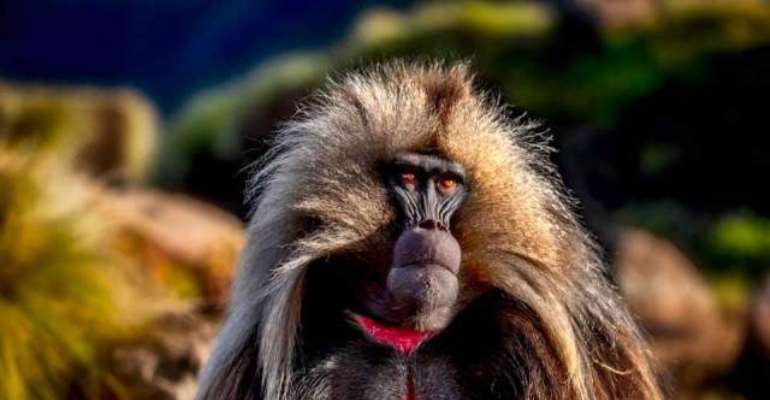In Ethiopia, unlike its neighbouring African countries to the south, the “big five” of animals to encounter are completely different.

In the traditional safari countries of Africa, like Kenya and Tanzania, the big five are elephants, lions, leopards, rhinos, and cape buffalos. A lot of safari participants are also enamored with giraffes and hippos, when they go on these safaris. This is not the case in Ethiopia, home of some of the most dramatic and beautiful vistas in Africa. In Ethiopia, the "big five" are the Ethiopian wolf, gelada baboon, walia ibex, mountain nyala, and Menelik’s bushbucks.
Ethiopia is a land of natural contrasts, from the tops of the rugged Simien Mountains (4620 meters), the third highest mountains in Africa, to the depths of the Danakil Depression, at 120 meters below sea level — one of the lowest dry land points on earth. The wealth of natural beauty that blesses Ethiopia offers an astonishing variety of landscapes and wildlife. Afro-Alpine highlands soaring to around 4,620 meters, moors and mountains, the splendor of the Great Rift Valley, white-water rivers, savannah teeming with game, giant waterfalls, dense and lush jungle... the list is endless.
With 14 major wildlife reserves, Ethiopia provides a microcosm of the entire sub-Saharan ecosystem. Birdlife here is abundant, and there are many endemic mammals from the rare Walia Ibex to the Ethiopian Wolf, from the Mountain Nyala to the Gelada Baboon that roam free just as nature intended. These offer amazing opportunities for nature and wildlife travel unparalleled in Africa.
Desale Mitiku Asfaw, CEO of Grand Holidays Ethiopia Tours, says, “The scenic views in Ethiopia in places like the Simien Mountains National Park and the ability to see rare animals and even be able to sit near the gelada baboons while they go about their normal routines are all treats for our visitors. Families with young children particularly enjoy our tours featuring Ethiopia's big five.
The Ethiopian Wolf (Canis simensis)
The Ethiopian wolf, also known as the Simien jackal or Simien fox, is The Ethiopian wolf is Africa’s most endangered carnivore and the world’s rarest canid.
It is native to the Ethiopian Highlands and can be seen in the Bale Mountains and Simien Mountains and other parts of the Ethiopian Highlands.
Gelada Baboon
The Ethiopian Highlands, particularly Semien Mountains to the north and west of the Rift Valley, is considered to be the finest place to spot gelada Monkeys. They are also referred as the sacred heart due to the naked patch of bright skin on their chests.
The geladas are more striking in appearance than the common baboons with a thick silky brown hair. These baboons are only found in the Ethiopian highlands. The most interesting fact about these endemic animals in Ethiopia is that they are the only primates whose primary source of food is grass.
Walia IBEX
Confined only in Afro-alpine habitat of Semien Mountain National Park in Ethiopia, the Walia Ibex (wild goat) is another endemic animal of Ethiopia. Walia Ibex are easily distinguished by their striking colour and magnificent arching horns. This wildlife species is typically active early in the morning and late in the afternoon, with a distinct resting period in the middle of the day.
Mountain Nyala
The Mountain Nyala, Mountain Nyala is a magnificent antelope endemic to the Ethiopian highlands east of the rift valley. These species are one of the endemic animals in Ethiopia.
It is one of the largest antelope, standing over 4 feet at the shoulder. Males have a set of curled horns while females have no horns, but rather long necks and large ears, which are very conspicuous.
Mountain nyala are known to inhabit three major mountain ranges that form a chain along the east side of the Rift Valley: the Chercher, Arussi and Bale Mountains. The majority of mountain nyala are found in the Bale Mountains, where most of the southern slopes are densely forested
Menelik’s Bushbucks (Tragelaphus seriptus meneliki)
Belonging to the same family as the Mountain Nyala; Menelik's Bushbuck is also fairly widespread and can be seen in much of Ethiopia's highland forest up to the treeline at 4,000 metres (13,000 ft.) Among other places, it can be commonly spotted in the Bale Mountains and Simien Mountains National Park.
“As the word gets out that Ethiopia has a rich but different animal experience, we expect the current growth trend to continue,” says Mitiku Asfaw.
Gelada baboons will sit close to visitors and go about their normal routines. Visitors can relax in the midst of hundreds of baboons in the Simien Mountains and amass great photos and videos. Photo courtesy Kevin Dooley.

